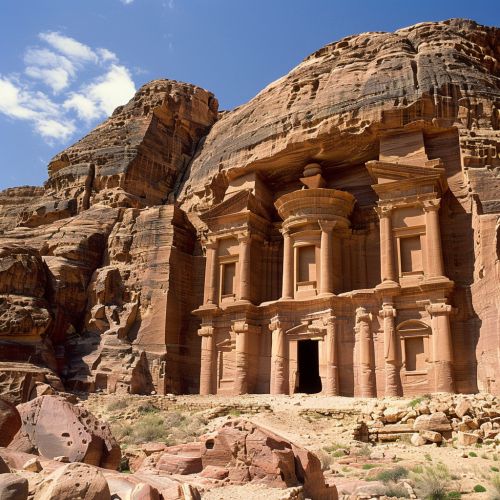History of Jordan
Prehistoric and Ancient Jordan
The history of Jordan dates back to ancient times, with evidence of human habitation in the region as early as the Paleolithic period. Archaeological findings suggest that the area now known as Jordan was home to some of the earliest human settlements, including the Natufian culture, which thrived around 12,000 BCE. The region's strategic location at the crossroads of Asia, Africa, and Europe made it a melting pot of cultures and civilizations.
During the Bronze Age, Jordan was part of the Canaanite civilization, which included the ancient cities of Amman (known as Rabbath Ammon), Jerash (Gerasa), and Petra. The Canaanites were known for their advanced urban planning, trade networks, and the development of early writing systems.
The Iron Age and Biblical Period
In the Iron Age, Jordan was divided among several small kingdoms, including Ammon, Moab, and Edom. These kingdoms are frequently mentioned in biblical texts and played significant roles in the region's history. The Ammonites, Moabites, and Edomites were known for their conflicts with the Israelites and other neighboring peoples.
The most famous ancient city in Jordan is Petra, the capital of the Nabataean Kingdom. The Nabataeans were an Arab people who established a prosperous trading empire in the region, controlling key trade routes and developing advanced hydraulic engineering techniques. Petra, with its rock-cut architecture and sophisticated water management system, became a major cultural and economic center.


Hellenistic and Roman Periods
Following the conquests of Alexander the Great, Jordan became part of the Hellenistic world. The region was ruled by the Ptolemaic and Seleucid empires before coming under the control of the Roman Empire in the first century BCE. The Romans incorporated Jordan into the province of Arabia Petraea, with Petra serving as the provincial capital.
The Roman period saw significant urban development in Jordan, with the construction of cities such as Philadelphia (modern-day Amman), Gerasa (Jerash), and Gadara (Umm Qais). These cities featured typical Roman architectural elements, including theaters, temples, and colonnaded streets. The Roman influence also brought about the spread of Christianity in the region, with several early Christian communities established in Jordan.
Byzantine and Early Islamic Periods
In the fourth century CE, Jordan became part of the Byzantine Empire. The Byzantine period was marked by the construction of numerous churches and monasteries, reflecting the region's growing Christian population. The city of Madaba is famous for its Byzantine mosaics, including the Madaba Map, a detailed mosaic map of the Holy Land.
The early seventh century saw the rise of Islam and the subsequent Arab conquest of Jordan. The region became part of the Rashidun Caliphate, followed by the Umayyad and Abbasid caliphates. The Umayyads established several desert palaces in Jordan, such as Qasr Amra and Qasr al-Kharanah, which served as retreats and administrative centers.
Crusader and Ayyubid Periods
During the Crusades, Jordan was a battleground between the Crusader states and Muslim forces. The Crusaders built several castles in Jordan, including Kerak and Shobak, to secure their hold on the region. These castles played crucial roles in the defense and administration of the Crusader territories.
The Ayyubid dynasty, founded by Saladin, eventually recaptured Jordan from the Crusaders in the late twelfth century. The Ayyubids reinforced the region's fortifications and continued to develop its infrastructure.
Mamluk and Ottoman Periods
In the thirteenth century, Jordan came under the control of the Mamluk Sultanate. The Mamluks maintained the region's strategic importance, constructing caravanserais and fortresses to protect trade routes and pilgrims traveling to Mecca.
The Ottoman Empire annexed Jordan in the early sixteenth century. Under Ottoman rule, Jordan remained a relatively quiet and underdeveloped province. The Ottomans administered the region through local tribal leaders and maintained a minimal military presence.
Modern History
The Great Arab Revolt and British Mandate
During World War I, the Great Arab Revolt against Ottoman rule was launched from Jordan, led by Sharif Hussein bin Ali and supported by the British. The revolt played a significant role in the eventual defeat of the Ottoman Empire and the establishment of the modern state of Jordan.
Following the war, the League of Nations granted Britain a mandate over the territories of Palestine and Transjordan. In 1921, the Emirate of Transjordan was established under the leadership of Emir Abdullah I, a member of the Hashemite family. The British mandate period saw significant political and economic development in Jordan, including the establishment of modern infrastructure and institutions.
Independence and the Hashemite Kingdom
Jordan gained full independence from Britain in 1946, becoming the Hashemite Kingdom of Jordan with Abdullah I as its first king. The early years of independence were marked by political challenges, including the 1948 Arab-Israeli War and the subsequent influx of Palestinian refugees.
King Abdullah I was assassinated in 1951, and his grandson, King Hussein, ascended to the throne in 1952. King Hussein's reign saw significant modernization and development in Jordan, as well as efforts to navigate the complex political landscape of the Middle East. Jordan faced several challenges during this period, including the 1967 Six-Day War, which resulted in the loss of the West Bank to Israel, and the Black September conflict in 1970, which involved clashes between the Jordanian army and Palestinian militant groups.
Recent History
King Hussein's death in 1999 marked the end of an era, and his son, King Abdullah II, succeeded him. Under King Abdullah II's leadership, Jordan has continued to pursue economic reforms and modernization efforts. The country has also played a key role in regional diplomacy, particularly in efforts to resolve the Israeli-Palestinian conflict.
Jordan has faced several challenges in recent years, including the impact of the Syrian civil war and the influx of Syrian refugees. Despite these challenges, Jordan remains a stable and influential country in the Middle East.
